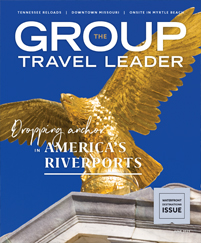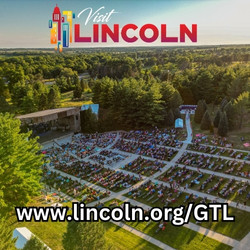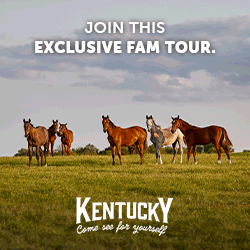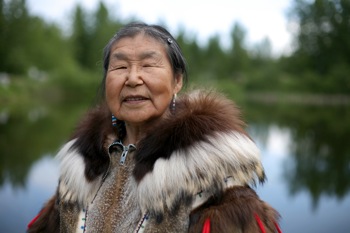 Photo courtesy Alaska Native Heritage Center
Photo courtesy Alaska Native Heritage Center
In recent decades, Americans have become increasingly aware of the native groups that live around the country. Native American cultural tourism has grown as well as museums, monuments and other attractions springing up to honor Native American heritage around the country.
Today’s traveler can learn about Native American culture in Alaska, North Carolina, New Mexico and hundreds of points in between. And tour operators in the West are offering itineraries that give groups an unprecedented look at the past and present of indigenous Americans.
Alaska Native
Heritage Center
Anchorage, Alaska
A new emphasis on interactivity and cultural demonstrations is buoying the Alaska Native Heritage Center in Anchorage. During the long winters, the Heritage Center provides education for young people from the state’s five indigenous groups. Those students turn around and present their heritage and culture to the flood of tourists who visit Alaska during the pleasant summer months.
“We usually hire interns from high school or college, or we hire elders for the summer,” said public relations representative David Farve. “By the end of the summer, they can give a tour and feel confident enough about their culture to share their stories with people from all over the world.”
Visitors who come to the center are likely to see performances of native dance, games or music. In an outdoor area, a quarter-mile loop around a small lake takes visitors to five interpretive village sites that are set up to represent the five different cultures in Alaska.
Each site uses authentic dwellings and objects such as polar bear hides, musk ox furs and harpoons to help demonstrate traditional lifestyles.
Beginning last year, the center moved many of its young interns into these villages to demonstrate the crafts and historic customs they were learning.
“Regalia is starting to become an endangered art form,” Farve said. “So all the kids who worked here last year had to work with an elder and learn how to make regalia.
“The regalia they made last year will be worn by our interpreters this year at the village sites. Now when a bus shows up, they see all of these people working on regalia, telling stories and talking with the visitors.”
Eastern Band of Cherokee Indians
North Carolina
Forced removal and the Trail of Tears took most of the Cherokees from the eastern United States to Oklahoma in the 1830s. But there was a contingent that simply didn’t leave and more who walked the long road back to their tribal lands after federal troops had left. Today, the Eastern Band of Cherokee Indians is a thriving group of about 13,000 in North Carolina.
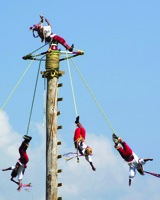 |
| Courtesy Eastern Band of Cherokee |
Like many native groups, the Eastern band of Cherokees opened a casino, and gaming revenues allowed them to buy back some of their ancestral lands in North Carolina. Today, groups can visit the area and learn about Cherokee history and culture.
“When I put together a group tour package, a lot of people like the hands-on stuff here in Cherokee,” said Frieda Huskey, the receptive tour coordinator for Cherokee Travel and Promotions. “We like to get their hands on our culture.”
Many groups start with a tour of the area led by Cherokee step-on guides who are well versed in the tribe’s history. The tours often stop at Oconaluftee Village, a historic re-creation site that shows what Cherokee life was like in the area in the 1700s. Interpreters demonstrate activities such as basket weaving and pottery for visitors.
Groups can also get involved in a variety of ways.
“A lot of groups that we’ve dealt with are interested in our culture and history and doing hands-on stuff,” Huskey said. “So we have some craftspeople that will teach groups to make a honeysuckle mat to take home with them, or they can teach them to do beadwork.”
The Cherokee offer traditional meals to guests, serving dishes such as native bean bread, rainbow trout and native greens. Guides will also take visitors on nature walks, pointing out plants and animals that were key to traditional native life.
These experiences have helped to grow interest in Native American culture among travelers.
“It’s very popular now,” Huskey said. “A lot of tours are coming through, and that’s their main thing. They want to learn about our culture and history, and they’re amazed at our economic development.”
New Mexico
The western United States is full of hundreds of native groups, many of whom offer some kind of tourism experience. One of the most developed Native American tourism scenes is in New Mexico, a state that enjoys an especially rich Indian heritage.
“There are 22 tribes in the state of New Mexico and 19 pueblos that have been around for eons,” said Travis Suazo, tribal tourism director at the New Mexico Department of Tourism. “With the arrival of the Spanish and the trading that took place up and down the corridor into South America, we’ve been welcoming visitors for many centuries.
“Today, all 22 groups engage in a form of tourism, from Vegas-style gaming to tribal communities that have resorts, golf courses, spas and stores.”
Gaming has become an important economic and tourism engine for 14 of the tribes in the state, but cultural tourism is also alive and well. One example is Albuquerque’s Indian Pueblo Cultural Center, a modern museum that introduces visitors to the culture, history and art of the 19 pueblos throughout the state.
Many groups take some time to explore the cultural center before beginning their journey into tribal lands.
“The Pueblo of Acoma provides visitors with a cultural experience, with a one-hour tour of Old Acoma on top of a sandstone mesa,” Suazo said. “A little bit west of there, you can go to the Pueblo of Zuni where, historically, the first contact with Europeans happened.”
In 1992, the governor of New Mexico created Suazo’s position in the tourism department to actively promote American Indian tourism and to help the native groups tell their stories in the ways they see fit.
Today, Native American attractions are some of the state’s most important, and they make up the second-most-visited section of the Department of Tourism’s Web site.
Suazo said the increased interest in American Indian tourism has come hand in hand with a demand for real-life encounters.
“A lot of it centers on authenticity,” he said. “People want a real experience and an interaction with the tribal members that they visit. They’re very eager to learn about the meaning of a dance that they view and the regalia that’s being worn. They like interaction, and they value it highly.”
Crazy Horse Memorial
When sculptor Korczak Ziolkowski took the invitation from South Dakota tribal elders to carve a massive monument to spiritual leader Crazy Horse in one of the mountains in the Black Hills, many people thought he was crazy. Ziolkowski worked on the monument from the 1940s, and when he died in 1982, only parts of the face of the figure were visible.
 |
| Courtesy Crazy Horse Memorial |
But Ziolkowski’s wife and family have continued his effort since his death, and this massive project, which is still ongoing, has become a keystone of South Dakota’s Native American tourism offerings.
“People used to think that Korzcak was crazy,” said Pat Dobbs, Crazy Horse Memorial’s media specialist. “But now, the public is starting to see more and more of that mountain being carved. We’re seeing more and more interest from a wider region now.”
The site has grown far beyond a construction zone to include a large visitors center where guests can learn about the history of the project and see a small-scale model of what the monument will look like when complete.
There’s also the 40,000-square-foot Indian Museum of North America, which has examples of clothing, headdresses, archaeological items and Native American art from the Northern Plains and other parts of the country.
The site has become so popular that in 2007, Globus and Tourism Cares named Crazy Horse an official “American Icon.” Today, groups visit from all parts of the United States.
“We’re starting to see larger numbers of groups of American people of color coming out of the South and Southeastern states,” Dobbs said. “We’ve also had more Native Americans, particularly elders, in tour bus groups.”
Go Native America Tours
The growing interest in Native American cultural tourism helped Sarah Chapman to launch her company, Go Native America Tours, in the late 1990s. Her first tour was an informal arrangement of nine people who wanted to see some of the native sites featured in a picture book her husband had published.
“We had no experience whatever in putting together a tour,” Chapman said. “But it was such a success that most of the people wanted to come back again the same year. Then we advertised, and it was like opening the floodgates.”
Today, the company operates a number of itineraries, both day tours and multiday excursions, that highlight some of the best-kept secrets in Indian country. Tour options include the Black Hills, the Bighorn Mountains, Yellowstone, Arizona, Montana, Alaska and even Hawaii.
The company specializes in finding sites that aren’t widely visited by tourists.
“In travel, there are places that can just blow your mind completely, but many people drive past them, because they don’t know that they’re there,” Chapman said. “There are so many places out here that are really important native history sites. Sometimes, even the state tourism people don’t realize what’s here.”
Go Native America also helps make the tours authentic by hiring all native guides and encouraging them to tell stories that reflect their people’s points of view. The real-life perspective seems to resound with customers.
“People say this is a once-in-a-lifetime tour, but we have a 60 percent return rate,” Chapman said. “Once people have been into real Indian country, they can’t stop coming back.”







